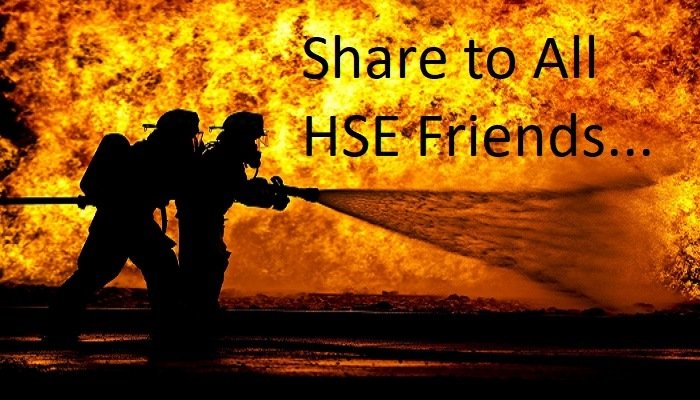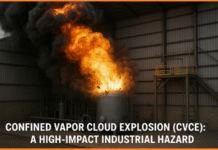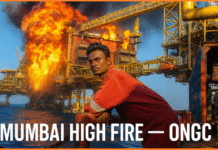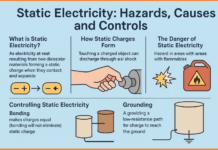Contents
Factors Contributing to Fire:
They are many. Some are easily detectable while some are hidden. Easy detectable factors contributing to fire are as under:
- Easy availability of combustible material like rubbish, solvent, paper, wood etc.
- Easy availability of air, oxygen or any oxidizing material.
- Sources of ignition like spark, static discharge, contact of hot surface, friction etc.
- Continuous running machinery without proper lubrication and maintenance.
- Non flame proof electrical fitting in flammable areas.
- Habit of smoke in flammable areas.
- No provision of fire detectors in fire prone areas.
- No provision of fire extinguishers in fire prone areas.
- Open handling of flammable substances.
- No compliance of fire safety rules.
- Chemical reaction going out of control.
- Sudden stoppage of cooling media protecting flammable reaction or distillation of solvent.
- Trapping of metal parts, nails etc. in rollers or moving machinery giving sudden spark.
- Non availability of inert material on reaction of flammable substance.
- Sudden lightning from the sky.
Common Causes of Industrial Fire:
One study of more than 19000 fires in industrial plants revealed the following causes of fire:
| Causes of Fire | % Share |
| Electrical | 19 |
| Friction | 14 |
| Foreign substance | 12 |
| Open flames | 9 |
| Smoking & matches | 8 |
| Spontaneous ignition | 8 |
| Hot surface | 7 |
| Not determinable | 7 |
| Combustion sparks | 6 |
| Miscellaneous | 5 |
| Overhead materials | 3 |
| Static electricity | 2 |
| Total | 100% |
Another study of more than 25000 fires reported to the Factory Mutual Engineering Corporation from 1968 to 1977 gives following causes:
| Causes of fire | % Share |
| Electrical | 22 |
| Incendiaries (deliberate fire) | 10 |
| Smoking | 9 |
| Hot surface | 9 |
| Friction | 7 |
| Overheated materials | 7 |
| Cutting & Welding | 7 |
| Bruner flames | 6 |
| Spontaneous ignition | 5 |
| Exposure | 4 |
| Combustion sparks | 3 |
| Molten substance | 2 |
| Static sparks | 2 |
| Chemical action | 1 |
| Lightening | 1 |
| Miscellaneous | 3 |
| Mechanical sparks | 2 |
| Total | 100% |
Above percentage indicates the frequency of fire causes. It is not indicative of their relative importance at particular plant, place or property. These are old figures and old causes. Change in causes is always possible.
These causes can be subdivided in many sub causes as under:
Sparks may be mechanical, electrical, static, due to cutting and welding etc.
Hot surface may be due to bearings and shafting, stove, heaters and small appliances, petrol, kerosene, LPG, acetylene, or alcohol, torches, potable furnaces, blow torches, smoke pipes, chimneys, flues and stacks, stationary heating device, gas fired appliances such as stove, heaters, boilers, salamanders etc.
Spontaneous ignition is due to oxidation of fuel where air is sufficient but ventilation is insufficient to carry away the heat as fast as it is generated. Exposure to high temperature and presence of moisture increases the tendency toward spontaneous ignition. Wet unslaked lime and sodium chlorate, rags or waste saturated with linseed oil or paint, sawdust, hay, grains etc, and finally divided metals promote spontaneous ignition.
Hazardous chemicals and metals like phosphorous, sodium, potassium, oxidising materials, nitro-cellulose film and pyroxylin plastics, fuels, solvent, lubricants, wood, paper, cloth and rubber products, sprays and mists, LPG and other flammable or explosive gases are known for fire hazards.
Hyperboles, pyrophoric substances, adiabatic compression, radiation, catalytic action, natural sources, lightening, cooking equipment, electrical distribution and installation, static electricity, arson, rubbish, playing with fire, hand tools, pallet material storage and explosive dust, gas, vapour or air mixture are all causes contributing to fire.
Common causes of industrial fire and remedial measures:
| Cause | Remedial Measure | |
| 1 | Electricity | Standard and safe wiring, over load protection, double insulation and earthing on portable equipment, ELCB, RCCB and waterproof cord in wet environment, use of proper flameproof equipment in hazardous area and periodical inspection. |
| 2 | Bad house keeping | Storing rubbish, waste, oil, grease etc. in a waste-bin with closed cover, regular cleaning and inspection, bund (dyke) to storage tanks of flammable liquids, dust collectors, safe disposal, and incineration. |
| 3 | Bidi -Cigarette | No-smoking notices, separate smoking booths, checking of match box, lighter etc. at security gate. |
| 4 | Hot surface | Good insulation, fencing, ducting for smokes and flue. |
| 5 | Friction | Good lubrication, proper belt tension, alignment, dust removal, inspection and maintenance. |
| 6 | Excessive Heat | Cooling, temperature controls, trained operators and supervisor. |
| 7 | Welding, cutting | Special place or partition, heat resistant floor, spark control, keeping flammable substance away, hot work permit, flammability test in tank before hot work, Fire booth, use of proper equipment. |
| 8 | Flame and combustion | Proper design, operation and maintenance, sufficient ventilation and ignition safety, heater insulation, hood, chimney, keeping flame away, trips and interlocks. |
| 9 | Self ignition | Keeping environment cool and dry, necessary ventilation and protection, keeping dusts and passages of waste and smoke clean, separate store of highly flammable materials, not to put oil soaked rags on hot surfaces, lagging and cladding, small vessels, good housekeeping. |
| 10 | Exposure | Barrier wall, sprinklers on fire path, wire glass in windows. |
| 11 | Ignition sparks | Proper equipment, closed combustion chamber, spark arrester on flammable vent and vehicle exhaust, flame trip. |
| 12 | Mechanical sparks | Machine guarding to avoid entry of foreign particle, fencing, magnetic separator, non-sparking tools. |
| 13 | Molten hot substance | Proper equipment with handles, better operation and maintenance, non-mixing of water. |
| 14 | Static electricity ( Due to belt drive, paper/plastic reeling, human body, pneumatic conveying, dust handling, liquid mixing, flow in vessel or pipe agitation etc. | Grounding, bounding, ionisation and humidification, vehicle earthing while transfer through pipeline, earthing of vessel, equipment and piping, flow rate reduction, avoiding flammable atmosphere, splashing and settling, using earthed probe, antistatic device, conductive shoes and flooring, copper earthing with earth resistance less than 10 ohm, additive to change liquid resistance, keeping filters away from storage tanks, extending inlet pipe up to bottom to avoid free fall of liquid, non-conductive parts and earthing of level gauges, avoiding oil drops in water, small size of non-conducting plastic containers, using N2 instead of CO2 as inert gas, electrostatic eliminators on paper/plastic reeling machines, use of radioactive ionisation etc. |





